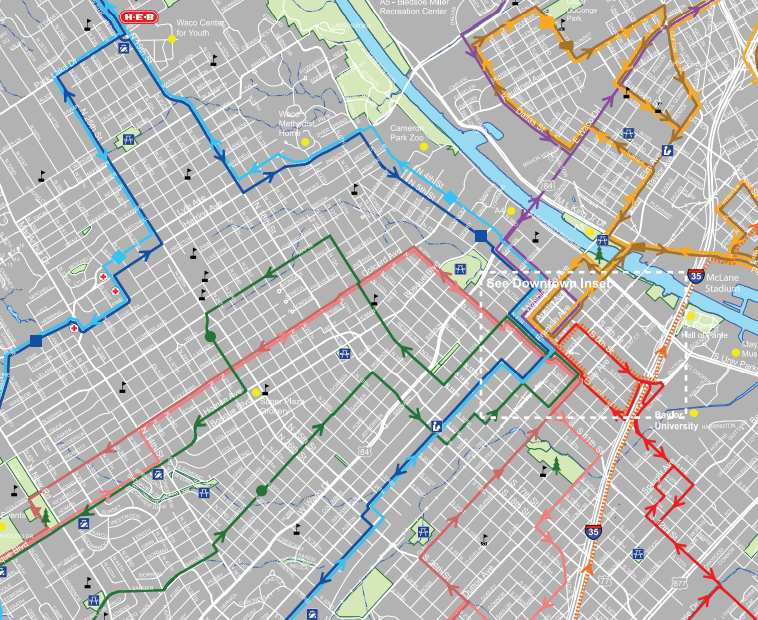Civic Insights: The Why of Bus Rapid Transit (BRT)
(City council, school board, planning commission, county commissioners – these groups and several others represent us. They do the day to day work of running our community. It is our responsibility to keep informed about their work so that we can help them represent us effectively. “Civic Insights” by Jeffrey Vitarius is a regular feature of Act Locally Waco. Its purpose is to help us understand decisions that shape our community so that we can participate effectively as informed, engaged residents of Waco. – ALW)

By Jeffrey Vitarius
We hope you all had a safe and enjoyable Thanksgiving and thought it might be good to start back up with a topic we find particularly interesting, bus rapid transit (BRT).
Next Thursday (December 10th, 2020) at 6:00 pm Waco Transit, the Waco Metropolitan Planning Organization (MPO), and AECOM Technical Services are hosting a virtual meeting to gather public input on station locations and designs for the BRT project. AECOM also recently provided updates to the City Council and MPO on the progress of the project. Let’s take a look at why this project is being considered and what stage of the process we are in now.
Way back in 2013-4, the City of Waco commissioned an Economic Development Strategic Plan from the W.E. Upjohn Institute for Employment Research. The study is generally called the Upjohn Report. Unlike a standard economic development strategy that focuses purely on the “general economic performance of the area,” the City “called for a plan to also reduce poverty, increase labor force participation, and increase area income.” That is, rather than focus on economic growth in and of itself, the plan also focused on how that growth might be made equitable for the people of Waco. This focus on equitable development rather than just any development remains an important goal of the City.
In the process of drafting their report, the Upjohn team interviewed ninety individuals, asking them (in part) about what challenges they see to finding and retaining employment. The result, “transportation was overwhelmingly cited as the most prominent barrier to finding and keeping a job.” In 2018, about 8% of Wacoans got to work by a means other than a car. At that time approximately 29% of Wacoan households had no car or 1 car. The average household size in Waco is about 2.5 people meaning that having one car could mean a household is still reliant on a non-car means of getting to work.
Although walking or cycling remain valuable commuting options for folks (your author does so whenever he can), needing to rely on your feet or your bike makes you vulnerable to long distances and poor weather (especially August heat). Given these challenges, it is critical for those in Waco who do not have ready access to a car that public transit gets people where they need to go reliably and as swiftly as possible.
The current Waco transit system is configured as a “spoke and hub.” In this design bus routes extend out from the City core to residential neighborhoods, job centers, and service locations before returning Downtown. The routes out and back are the “spokes” with the Downtown Transit Center as the “hub.” The transit map below shows how the various routes converge at the transit center downtown before spanning out across the city.

(Map 1)
This configuration has its challenges. The spoke and hub setup means that to get from one side of town to the other, an individual has to transfer at the “hub,” lengthening travel times. Additionally, the variety of routes mean that each route can only be run once an hour (in the case of East Waco the route runs varying directions based on what hour of the day it is).
BRT may be the solution to these issues. The BRT would run through the middle of the city extending from Woodway through Downtown Waco and on to Belmead and Lacy Lakeview. The BRT would make fewer stops and be timed to traffic. This would, theoretically, reduce the delays caused by passengers entering and exiting the bus as well as the delays caused by sitting in traffic. The goal of such a system would be to maximize the time the bus is in motion, therefore reducing travel times. It is also hoped that such a system would generate more frequent bus service and bus services that extend more into weekends and evenings (an important factor when considering whether folks can get to work when they need to).
In 2018, the City received a feasibility study from AECOM Technical Services that looked at the potential system overall as well as a number of route, technology, and service operation options. The study recommended (after substantial public input) a route that ran from US 84 to New Road to Franklin Avenue to Taylor Street and Hillsboro Drive before taking US 84 to Loop 340. On May 1, 2018 the City Council approved the recommended route. Below is the most recent map of the proposed route.

Since then, the City, the MPO, and AECOM have begun the process of seeking federal funding for the project. In July of 2019, pre-award authority was granted that allows the City to begin pursuing projected development costs before receiving a formal award. Under this authorization the City sought services for preliminary engineering and environmental review. We are in the middle of that process now.
Preliminary engineering (think of this as preliminary technical design) needs to be completed to understand the final costs of the project and pursue the funding needed to cover those costs. Environmental review is required to make sure the project will not unduly damage Waco’s environment. Throughout this part of the process there are three different periods of public input planned. The first passed in October, when AECOM sought to reintroduce the project to Wacoans and update them on the project approach. The second is the meeting coming up on December 10. This one will focus on where stations will be and how they will function. Both of these aspects can have a huge impact on cost and operations down the line. Finally, in mid-February it is anticipated that the final results for this phase of the project will be brought before the public for review.
Other Interesting Items from the Agenda (to me)
- Over the last two meetings City Council has received information regarding a Municipal Settings Designation (MSD). In short, this would reduce a hurdle to development in the city’s core by prohibiting the future use of groundwater as potable (safe to drink). Without a Municipal Settings Designation each property owner would have to deal with testing and remediating groundwater contamination before development which can slow projects in an area where the city provides water to all properties anyhow.
- The City and WISD are working on a partnership to provide all WISD students with e-cards that would grant them access to the library’s substantial e-book catalogue.
- The J.H. Hines Elementary Sidewalks project continues with the city pursuing $101,918.37 in property acquisitions to account for right of way needs.
Meeting Basics
- City Council meets on the first and third Tuesday of every month. Work session – 3:00 pm / Business session – 6:00pm (there have been two meetings since our last post)
- To watch the recorded session click here (City of Waco Cable Channel, wccc.tv)
- For the full agenda click here (11/17) or here (12/01)
- For the meeting packet with the documents pertinent to the meeting click here (11/17) or here (12/01)

Jeffrey Vitarius has been actively local since early 2017. He lives in Sanger Heights with partner (JD) and his son (Callahan). He helped found Waco Pride Network and spearheaded its Vision 2025 process. Jeffrey works at City Center Waco where he helps keep Downtown Waco clean, safe, and vibrant. He is a member of St. Alban’s Episcopal Church and graduated from Baylor in 2011.
The Act Locally Waco blog publishes posts with a connection to these aspirations for Waco. If you are interested in writing for the Act Locally Waco Blog, please email [email protected]for more information.
